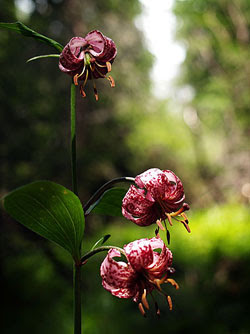
“Guardate gli uccelli del cielo; non seminano, non mietono, non raccolgono in granai, e il vostro padre celeste li nutre. Or, non valete voi più di loro? E chi di voi, per quanto si preoccupi può aggiungere alla durata della sua vita un solo cubito? E perché darsi tanta pena per il vestito? Guardate come crescono i gigli del campo: non lavorano, né filano, eppure vi assicuro che nemmeno Salomone, in tutta la sua gloria, fu mai vestito come uno di essi. Ora se Dio riveste così l’erba del campo, che oggi c'è e domani viene cast into the oven, not much more clothe you, O ye of little faith? So please do not angustiarvi saying, "What shall we eat? What shall we drink? What we wear? "Of all these things we give attention to the Gentiles, and now your heavenly Father knows that you need all this."
Gospel of Mark, 6, v. 26
The first time I saw a wild lily, in the mountains of Cadore, I went back to his mind this passage from the Gospel. I remember thinking that someone had thrown with the trash of bulbs grown along a slope. The bright orange flowers, which are open to the sky, were so treacherously bright be illuminated by the sun the whole lawn, removing light to all the other wild flowers.
I lilies (Jan. Lilium) are plants belonging to the family of Liliaceae, also once used in traditional medicine. Among the species that live in our mountains and our forests, Lilium martagon (pictured above and right) and bulbiferum Lilium croceum or are certainly two of the most representative. But obviously this is a genus of plants that offered a lot and that has much to offer to those who love these spectacular garden of colorful baroque chandeliers. Of course, in addition to many plant species the growers and fans have created countless hybrids and cultivars, so as to meet the needs of every palate.
 I think it is worth emphasizing how the lilies are victims of all kinds of pests and diseases. I'm definitely delicatine plants, so that I was an English lord who once said: " turkeys and lilies have one thing in common, namely the ambition to die . One of the most dangerous is the criocera lily, a small red beetle that feeds on it greedily, and against which the best defense remains constant observation combined with any manual elimination of pests. Not to mention slugs and millipedes, fungi and viruses ... In short, plants to be treated with care! How
I think it is worth emphasizing how the lilies are victims of all kinds of pests and diseases. I'm definitely delicatine plants, so that I was an English lord who once said: " turkeys and lilies have one thing in common, namely the ambition to die . One of the most dangerous is the criocera lily, a small red beetle that feeds on it greedily, and against which the best defense remains constant observation combined with any manual elimination of pests. Not to mention slugs and millipedes, fungi and viruses ... In short, plants to be treated with care! How
multiply lilies? Well, if our goal is not to try to select hybrids or varieties, the vegetative propagation of these plants is the most easily implemented, and most importantly we are in the best time. In late summer, take the bulbs and pull gently external scales that compose them, you may take up almost half, without the bulb and then die. In the case of species such as Lilium bulbiferum , you can use directly instead cloves growing leaf axil poster. Then take scales and / or bulbilli, mescolateli a sabbia e terriccio umidi e metteteli in un sacchettino di plastica trasparente. Soffiate dentro al sacchettino, quindi richiudetelo e lasciatelo in una posizone di ombra luminosa, in un punto riparato dalle gelate. Durante l'autunno e l'inverno i bulbilli produrranno radici, e le squame staccate formeranno a loro volta alla loro base dei bulbilli che radicheranno ben presto; in primavera vi ritroverete con delle minuscole piantine composte da una fogliolina, un piccolo bulbo e qualche radice, che trapianterete in vaso o direttamente all'aperto. piano piano i bulbi cresceranno, e presto avrete una nuova generazione di magnifici e splendidi gigli per adornare il vostro giardino.
Per finire, un'ultima raccomandazione. Se vi siete innamorati dei gigli selvatici ritratti nelle foto, vi prego: NON RACCOGLIETELI IN NATURA! Si tratta di specie spesso protette ed a volte in forte rarefazione per il degrado dei loro habitat. Per fortuna esistono vivai specializzati in cui poter trovare esemplari coltivati di specie selvatiche, a volte sotto forma di cultivar di particolare bellezza (come ad esempio la varietà bianca di Lilium martagon ) . Rivolgetevi a queste realtà vivaistiche, e lasciate alle nostre montagne questi fiori di eccezionale bellezza.

0 comments:
Post a Comment